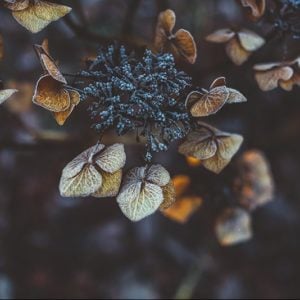The temperature of plants is like that of us humans: Some like it warm, others prefer mild. Some do quite well with extreme temperatures, but sudden cold will cause damage to all plants. What many don’t expect, frost damage can also occur to houseplants indoors.
Frost damage to houseplants can be a common issue, especially during cold weather or if your plants are placed near windows or doors with drafts. When you notice frost damage, it’s important to take immediate action to help your houseplants recover. Here’s what to do:
Move the Plant If your houseplant has been exposed to frost, the first step is to move it to a warmer, protected location. Place it away from drafty windows, doors, or any other cold spots. Find a spot with consistent temperature and minimal temperature fluctuations.
Assess the Damage Carefully examine the plant for signs of frost damage. Look for wilting, blackened or browned leaves, and mushy or water-soaked tissues. If the damage is severe, some parts of the plant may not recover.
Pruning Trim away any visibly damaged or dead leaves, stems, or branches. Use clean, sharp scissors or pruning shears to make clean cuts. Pruning helps the plant allocate its energy to healthier parts.
Gentle Watering Water the plant gently with lukewarm water. Avoid using cold water, as it can further stress the plant. Ensure that the pot has good drainage to prevent waterlogged soil.
Increase Humidity Frost-damaged houseplants may benefit from increased humidity. Place a tray of water near the plant, use a humidifier, or mist the plant regularly to raise humidity levels. This helps prevent further stress and dehydration.
Provide Light Place the plant in a well-lit area but avoid direct sunlight if the plant is still recovering. Houseplants may be more sensitive to intense sunlight after frost damage.
Wait and Monitor Give your plant some time to recover. Continue to monitor its progress and adjust care as needed. Recovery time varies depending on the extent of the damage.
Fertilize Sparingly Hold off on fertilizing your plant until you see signs of recovery. Feeding a stressed or damaged plant can worsen the situation. Once the plant starts showing new growth, you can resume regular feeding with a balanced fertilizer.
Prevent Future Frost Exposure Take steps to prevent future frost damage. Ensure your houseplants are not in the direct path of cold drafts, maintain a suitable indoor temperature, and consider moving them away from windows on extremely cold nights.
It’s important to note that the extent of recovery from frost damage can vary depending on the severity of the exposure and the plant’s resilience. Some plants may recover fully, while others may lose portions of their growth. Be patient and continue to provide appropriate care, and your houseplant has a good chance of regaining its health and vitality.
Contents
How frost damage occurs to houseplants
Frost damage to houseplants occurs when the plant is exposed to cold temperatures for several minutes. For example, due to prolonged airing in winter. Damage can occur after only 10 minutes. But also a location of your plant directly at a frequently opened window, can provide for cold damage. For tropical and subtropical plants this can already be the case at +5°C. It is recommended to keep an eye on the temperature in front of the window.

Detect cold and frost damage
While some plants just stop growing or flowering, others can be observed to have droopy leaves. After just a few minutes of frosty air, the leaves take damage. Then white spots can be seen on the leaf surfaces. This is a sign that metabolism is no longer possible. Often the lower older, and the upper younger leaves or shoots are affected first. A few days later, especially in exotic plants, you can observe that the leaves turn brown and die. If individual leaves die, the plant may survive. If the plant was exposed to sub-zero temperatures for a long period of time, the roots may freeze.
Treatment of frost damage
Many plants appear dead from frost damage, but recover. However, this may be somewhat delayed due to the stress the plant has had. So you should be patient here and wait a bit. Frost damage is best left until the plant resprouts. Dead leaves or parts of the plant that do not form new shoots can be cut off. When cutting off part of a leaf, leave a few millimeters of the dead leaf. This leaves the still-living leaf undamaged and the plant has more energy available for regeneration.
Prevention: winterize plants properly
In order to bring your plants over the winter without damage, you should bring them into a winter quarter. Apart from the staircase, the cellar or the bedroom are also suitable. Read our overview on the subject of wintering plants.
Have you ever had frost damage to a plant? What did you do? Feel free to write us a comment, we are happy to receive tips.

